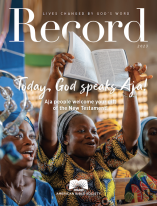5 Steps to a Successful Bible Reading Plan for Your Church
How to Start an Email-Driven Program in Your Faith Community
It was my first day as discipleship pastor at Browncroft Community Church. A key volunteer approached me and blurted, “We are two months behind in the Read365 program. What do you want to do?”
This was the stuff of nightmares. I hardly knew the program, much less the problem or how to fix it. I was about to get a crash course.
Seven years earlier my predecessor, Blake Shipp, along with a team of others had developed a Bible reading plan called Read365. People from Browncroft would write reflections on designated passages of Scripture. A software engineer had designed a platform for the writers and editors to do their work, and the software automatically dispersed the messages via the church website and to subscribers by email.
Immediately, the value of this endeavor became apparent. For the past seven years, the leadership of this church had removed certain barriers to Bible engagement. Read365 provided a plan for people to read Scripture daily, and it modeled how to reflect on those Scripture passages, using the creative insights of people from the church. With smart use of available technology, a significant group of church people entered a new conversation about the Bible every day. In many ways this program was ahead of its time.
Fast forward almost two years into my service at Browncroft. In a church of 1500, there are now 700 subscribers for Read365. The creative team of about 70 writers, editors and additional volunteers has continued to grow. We are in the midst of a software update and still learning as we go. Leading an every-day Bible engagement program has stretched and challenged me in many ways.
Is this something you could do at your church? If you’re willing to try, here are a few insights I have gathered:
1. Start with the Basics.
Often, when establishing a new church program, we want to start with a brainstorming session that generates a thousand ideas. That can sometimes yield exciting possibilities, but often it’s just distracting. What are the basics here? Developing a Bible engagement strategy means creating a platform for people to read the Bible daily. Start with that simple fact and build from there.
2. Build a Team.
Bringing other people into the conversation of Bible engagement allows for broader perspectives. It’s not just you preaching or teaching or driving a program. The writers, designers, thinkers, editors and planners can use their God-given gifts to assist others in reading Scripture. This is the body of Christ at work. As you involve a greater number of creative folks from the church, you build excitement within the church. The reflections are home-grown. They have specific local and personal application to the lives of the readers.
3. Connect the Dots.
A Bible engagement strategy can help you connect the dots from Sunday to the other six days of the week. In the 2015 Read365 program, for instance, we read through the book of Ecclesiastes; we also had a sermon series on the book. People could enter those Bible passages during the week with background and additional insight gained at church on Sunday. Part of any discussion about sermon planning, small groups and education must include how people can interact with Scripture between those experiences.
4. Humbly Embrace Imperfection.
People are imperfect. Technology is imperfect. We plan as best we can. We have multiple people editing and looking over details. Still, miscues happen. Don’t let the fear of imperfection keep you from making progress. You might list the wrong chapters or switch verses by mistake. Maybe your system will fail to send out all those emails. Keep the goal in mind: you are providing a path for people to engage Scripture. That makes it worth the bumps along the way.
5. Re-evaluate.
As I said earlier, we’re in the process of making a software change. This year we have taken steps to add intro videos to books of the Bible (click here to watch). Leading Bible engagement at the local church means continuing to look for ways to help people contextualize God’s Word in their own everyday lives. Regular evaluation allows you to keep improving at this. What’s working? What’s not? Be willing to experiment with new systems or technology as needed.
Matt, a young man from my church, calls himself “a novice to reading the Bible,” but he started using Read365 in the last year. He says it “has eliminated the intimidation factor on where to start and how to dive in to God’s Word. It has taught me the importance of discipline and accountability.… The best part of all is I’m just getting started!”
As you know, the time you take to assist people in engaging Scripture makes an eternal difference. To get ideas on starting your own daily Bible engagement strategy, check out the Browncroft Read365 page (browncroft.org/read365).

Peter Englert
Peter Englert serves as the Belong Director at Browncroft Community Church in Rochester, NY. He holds a B.A. of Pastoral Ministry and M.A. of Theology from the University of Valley Forge. His interests include coffee, great books, New York Yankees & Jets and basketball. He married his wife, Robyn, in October 2013. You can follow him at peterenglert.com and twitter @pdenglert.
Thanks to the support of our faithful financial partners, American Bible Society has been engaging people with the life-changing message of God’s Word for more than 200 years.
Help us share God's Word where needed most.
Connect with our Bible engagement blog for leaders and receive a Bible-reading Habit Guide for your community.









